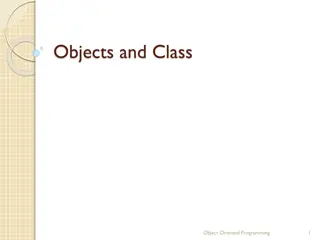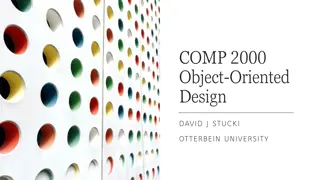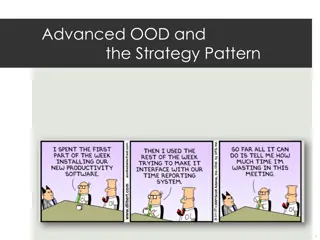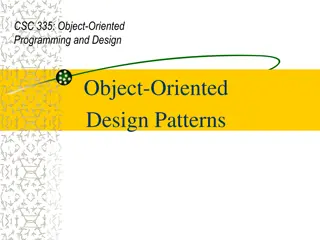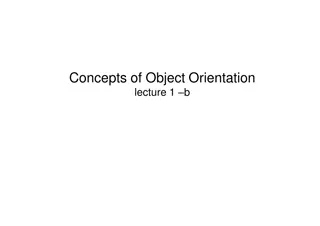
Steps in Object-Oriented Design and Implementation
Explore the steps involved in the analysis and design of an object-oriented system, from creating a use case model to drawing interaction and class diagrams. Understand how the conceptual model is transformed into an object-oriented model, enhancing the solution domain within technology-independent concepts. Dive into the detailed description of system construction and mapping objects to create a structured computational model.
Download Presentation

Please find below an Image/Link to download the presentation.
The content on the website is provided AS IS for your information and personal use only. It may not be sold, licensed, or shared on other websites without obtaining consent from the author. If you encounter any issues during the download, it is possible that the publisher has removed the file from their server.
You are allowed to download the files provided on this website for personal or commercial use, subject to the condition that they are used lawfully. All files are the property of their respective owners.
The content on the website is provided AS IS for your information and personal use only. It may not be sold, licensed, or shared on other websites without obtaining consent from the author.
E N D
Presentation Transcript
Subject Name: Information System: Analysis Design & Implementation Subject Code : BCA 602 (N) Topic : Object Oriented Design HIMANSHU SHUKLA Department of ComputerApplication UIET, CSJM University, Kanpur
Object Oriented Design After the analysis phase, the conceptual model is developed further into an object-oriented model using object-oriented design . In Object Oriented Design, the technology-independent concepts in the analysis model are mapped onto implementing classes, constraints are identified, and interfaces are designed, resulting in a model for the solution domain. A detailed description is constructed specifying how the system is to be built on concrete technologies. Design is concerned with the mapping of objects in the problem space into objects in solution space and creating an overall structure and computational model of the system.
Steps in the Analysis and Design of an Object Oriented System
1.Create a Use case model The first step in the analysis and design of an object- oriented system is to recognize the actors interlinked with the system. After that, create the use case and draw the use case diagram. 2. Draw activity diagram (If required) The activity Diagram demonstrates the dynamic nature of a system by creating the flow of control form activity. An activity addresses a procedure on some class in the framework that outcomes in an adjustment of the condition of the system. The below figure shows the activity graph handling a request to convey a few products.
3. Draw the interaction diagram : A interaction diagram shows a collaboration, comprising a bunch of articles and their relationship, including the messages that might be dispatched among them. Interaction diagram address the unique perspective on a system. Steps for drawing interaction diagrams : Initially, we ought to distinguish that the objects as for each use case. Then we draw the sequence diagrams for each use case. Then we draw the collaboration diagrams for each use case.
4. Draw the class diagram : The class diagram is responsible for showing the relationship between the classes. There are four types of relationships available in class diagrams Association It is a semantic connection between classes. At the point when an association associates two classes, each class can send messages to the next in sequence or a collaboration diagram. They may be bi-directional or unidirectional in nature. Dependencies They connect two classes and are always unidirectional in nature and display that one class, depends on the definitions of another class. Aggregations They are a stronger form of association that shows the relationship between a whole and its parts. Generalizations They are used to display an inheritance relationship between the two classes.
5. Design of State chart diagrams : A state chart is utilized to show the state space of a given class, the occasion that influences progress starting with one state then onto the next, and the activity that outcome from a state change. A state change graph for a book in the library management system is shown below
6. Draw component and development diagram : These diagrams address the static execution perspective on a system they are identified with class diagrams in that a segment ordinarily guides to at least one class, interface, or coordinated effort.
References: 1. www.tutorialspoint.com 2. www.geeksforgeeks.org 3. www.javatpoint.com 4. V. Raja Raman : Analysis and Design of Information Systems 5. Jeffrey L Whitten & Lonnie D Bently: System Analysis and Design Methods



